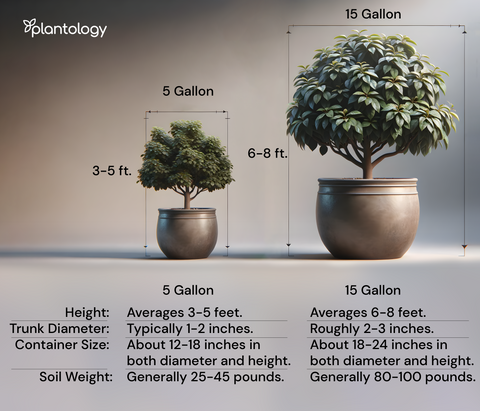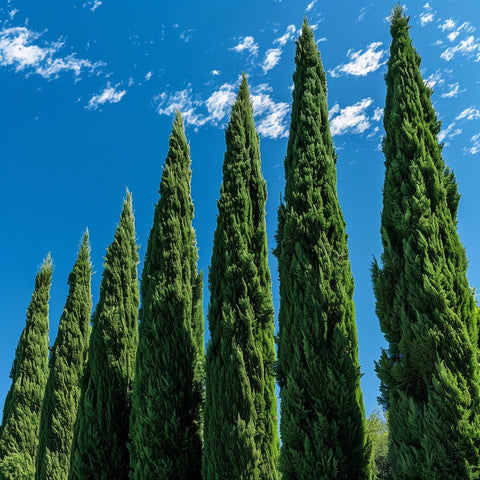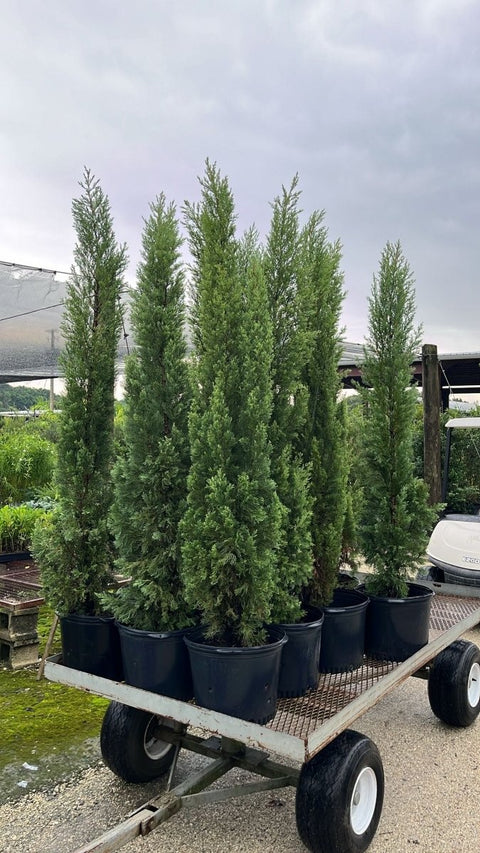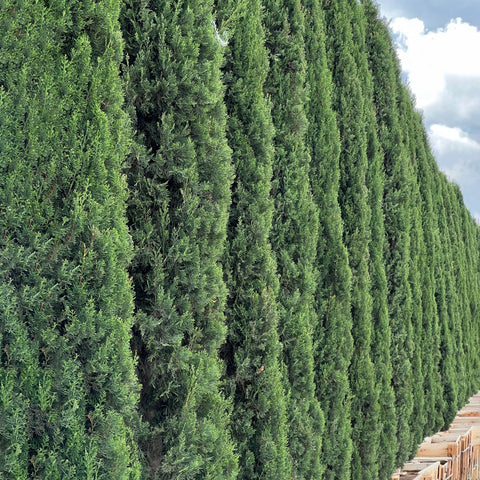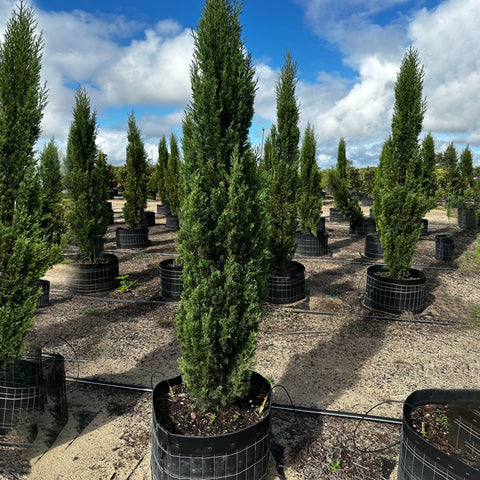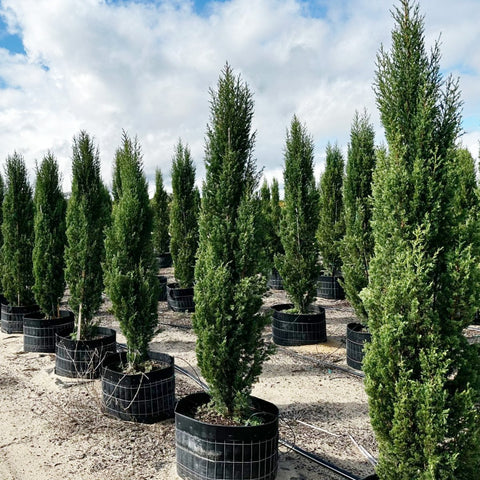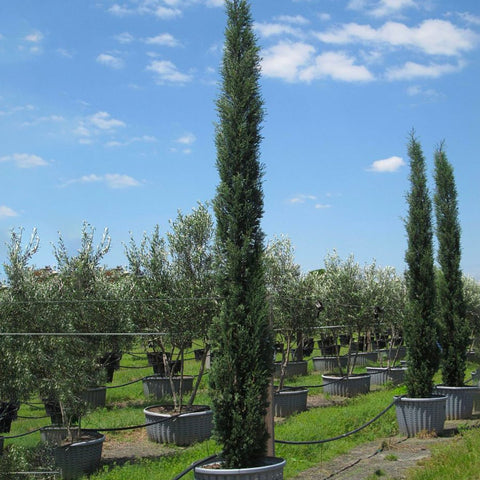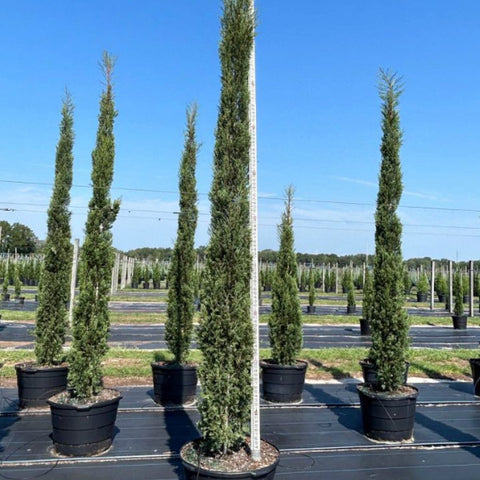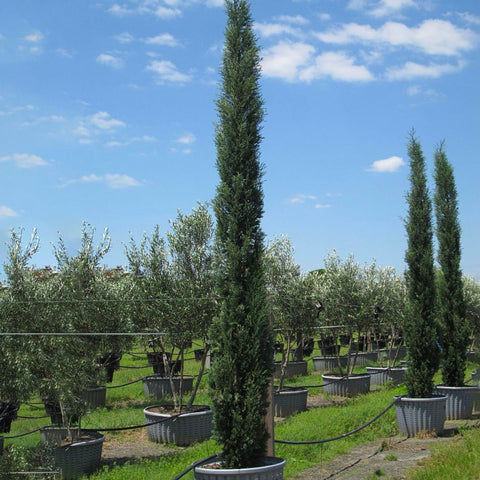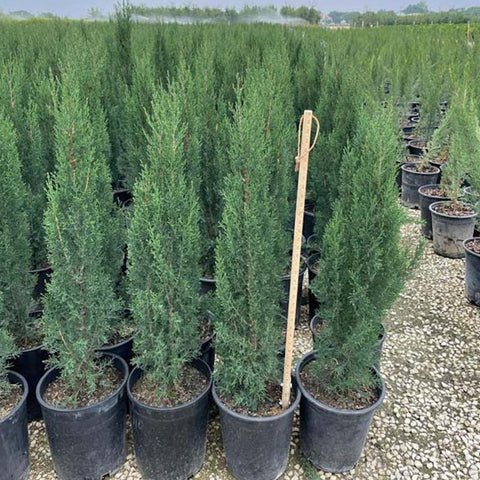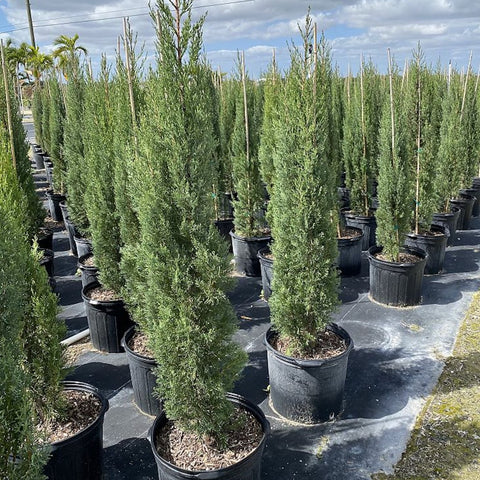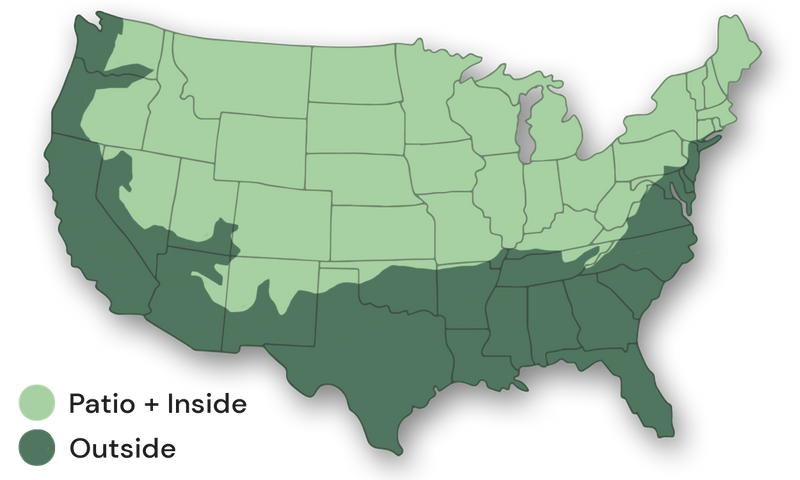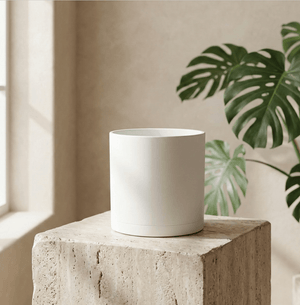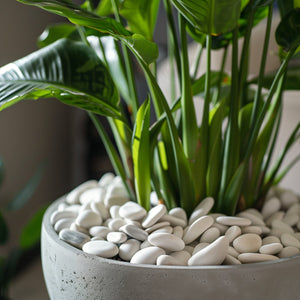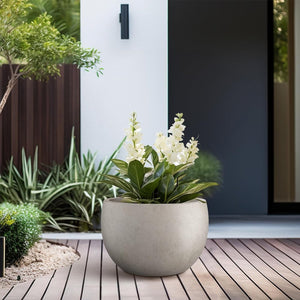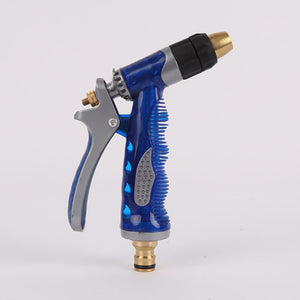Frequently asked question
Italian Cypress trees (Cupressus sempervirens) grow at a moderate to fast rate of 1-2 feet per year when established in optimal conditions. These elegant Mediterranean evergreens can reach their mature height of 40-60 feet within 20-30 years while maintaining their distinctive narrow columnar shape of just 3-5 feet wide.
Growth factors that affect Italian Cypress trees:
- Climate: They grow fastest in USDA zones 7-10 with full sun exposure
- Water: Regular watering during establishment accelerates growth
- Soil: Well-draining soil with proper nutrients supports optimal growth
- Spacing: Proper spacing (3-4 feet apart for hedges) prevents competition
- Maintenance: Annual fertilization can boost growth rates
Italian Cypress trees require minimal maintenance once established and are drought-tolerant, making them popular choices for creating privacy screens, windbreaks, and architectural focal points in Mediterranean-style landscapes.
For the fastest growth, plant young trees in spring, water consistently during the first year, and apply a slow-release fertilizer formulated for evergreen trees annually in early spring.
Italian Cypress trees (Cupressus sempervirens) are known for their remarkable height-to-width ratio, typically growing 40-60 feet tall while maintaining a slender width of only 3-5 feet. This dramatic columnar growth habit makes them ideal vertical accents in landscape design.
Key height characteristics of Italian Cypress trees:
Growth pattern: They grow upward rather than outward, creating a distinctive columnar silhouette
Mature height: Can reach 40-60 feet in optimal conditions, though 30-40 feet is common in most landscapes
Annual growth: Adds approximately 1-2 feet of height annually until reaching maturity
Proportions: Maintains a consistent 10:1 height-to-width ratio throughout its lifespan
Landscape impact: Creates strong vertical elements that draw the eye upward
In European landscapes, particularly in Italy and Greece, some specimens have reached heights of 80 feet or more over centuries. Their dramatic vertical presence has made them iconic elements in Mediterranean gardens, where they're often used to frame entrances, define property boundaries, or create elegant living walls.
When planning your landscape, remember to account for the eventual height of these majestic trees, particularly near power lines or structures.
Italian Cypress trees (Cupressus sempervirens) are renowned for their outstanding drought tolerance, making them ideal choices for water-wise landscaping in dry climates. Native to the Mediterranean region with its hot, dry summers, these evergreens have evolved efficient water usage mechanisms.
Drought tolerance characteristics of Italian Cypress:
Established trees can survive extended dry periods with minimal supplemental water
Deep root systems efficiently access available groundwater
Waxy needle-like foliage reduces evaporation and water loss
Natural adaptation to Mediterranean climate with dry summers
Lower water requirements compared to many other ornamental trees
While drought tolerant when established, Italian Cypress trees do require regular watering during their first 1-2 years after planting to develop strong root systems. During this establishment period, water deeply once weekly, then gradually reduce frequency as trees mature.
For optimal drought performance in extremely hot climates, consider applying a 2-3 inch layer of mulch around the base (keeping it away from the trunk) to conserve soil moisture and regulate soil temperature. Even with their excellent drought tolerance, these trees will perform best with occasional deep watering during extended drought periods.
Italian Cypress trees (Cupressus sempervirens) require specific spacing considerations to balance their aesthetic appeal with proper air circulation and root development. The ideal spacing depends primarily on your intended landscape purpose.
Recommended spacing guidelines for Italian Cypress trees:
Privacy screens/hedges: Plant 3-4 feet apart for a continuous green wall effect
Driveway or entrance lining: Space 5-6 feet apart for a formal, rhythmic appearance
Standalone specimens: Allow 6-8 feet between trees to showcase their individual columnar form
Foundation plantings: Position at least p feet from building structures
Mixed borders: Space 8-10 feet from other large shrubs or trees
Important spacing considerations:
When planted too closely (less than 3 feet apart), Italian Cypress trees may compete for nutrients and water, potentially stunting growth or increasing disease susceptibility. Insufficient spacing also reduces air circulation, which can create conditions favorable for fungal diseases, particularly in humid climates.
Conversely, spacing trees too far apart when creating a hedge or screen will leave gaps that take years to fill in, even as the trees mature. For the best combination of health and aesthetic appeal, follow the guidelines above while considering your specific landscape goals and regional growing conditions.
Italian Cypress trees (Cupressus sempervirens) have non-invasive root systems that grow primarily in a vertical pattern rather than spreading aggressively horizontally. This growth habit makes them considerably safer to plant near structures, walkways, and underground utilities compared to many other landscape trees.
Root characteristics of Italian Cypress trees:
Growth pattern: Primarily vertical, following the columnar shape of the tree above ground
Depth: Can develop deep roots reaching 10-15 feet in well-draining soils
Spread: Root spread typically remains within the drip line of the tree (3-5 feet)
Structure damage potential: Low risk to foundations, pavements, or underground pipes
Soil stabilization: Provides good erosion control without aggressive spreading
Unlike trees with invasive lateral root systems (such as willows, poplars, or certain maples), Italian Cypress trees can be safely planted relatively close to structures. While the general recommendation is to maintain at least 5-6 feet distance from foundations, this is primarily to prevent moisture issues rather than due to root invasion concerns.
The non-invasive nature of their root systems also makes Italian Cypress trees excellent choices for planting in raised beds, on slopes for erosion control, and in areas with limited root space. Their vertical root development complements their above-ground columnar form, creating a harmonious and structurally stable growing pattern.
Italian Cypress trees (Cupressus sempervirens) have specific watering requirements that vary significantly between their establishment phase and maturity. Proper watering is crucial for developing healthy root systems and preventing common issues like browning foliage or fungal diseases.
Italian Cypress watering schedule guidelines:
First year after planting: Water deeply once weekly, providing approximately 5 gallons per tree
Second year: Water every 10-14 days during growing season (spring through fall)
Established trees (3+ years): Water every 2-3 weeks during dry periods
Winter dormancy: Reduce watering to monthly in winter, except in extremely dry conditions
Drought periods: Increase frequency slightly during extended heat waves
Signs of improper watering:
Underwatering: Yellowing or browning needles, especially on outer branches
Overwatering: Soft, spongy soil around root zone, yellowing throughout the tree, root rot
Watering technique is as important as frequency. Always water deeply at the root zone rather than lightly spraying foliage. Deep watering encourages deeper root development and improves drought tolerance. Using a soaker hose or drip irrigation system around the base of the tree is ideal.
Mulching with 2-3 inches of organic mulch (keeping it away from the trunk) helps conserve soil moisture, reduce competition from weeds, and regulate soil temperature, significantly reducing watering needs in established trees.
Italian Cypress trees (Cupressus sempervirens) require minimal pruning compared to many landscape trees, as they naturally maintain their distinctive columnar shape without extensive human intervention. Their low maintenance requirements make them popular choices for busy homeowners and commercial landscapes.
Essential pruning guidelines for Italian Cypress trees:
Timing: Prune in late winter or early spring before new growth begins
Dead/damaged branches: Remove promptly regardless of season to prevent disease spread
Shaping: Light shaping can be done to maintain symmetrical appearance if needed
Width control: Trim sides lightly if the tree begins to widen beyond desired width
Height limitation: Not recommended as it can ruin the natural columnar form
What to avoid when pruning Italian Cypress:
Topping the tree (cutting the top off) permanently damages its natural form
Heavy pruning of interior growth can create bare patches that won't regenerate
Pruning during wet weather increases disease risk
Removing more than 1/3 of living material in a single year stresses the tree
Tools and techniques:
Use sharp, clean pruning tools disinfected with a 10% bleach solution or rubbing alcohol between cuts to prevent disease transmission. For routine maintenance, hand pruners work well for branches under ½ inch in diameter, while loppers are better for larger branches.
With proper care and minimal pruning, Italian Cypress trees will maintain their elegant columnar form for decades, requiring only occasional removal of dead material to keep them looking their best.
Italian Cypress trees (Cupressus sempervirens) demonstrate remarkable adaptability to various soil conditions, though they perform best in well-draining soils with moderate fertility. Their Mediterranean origins have made them particularly tolerant of less-than-ideal soil situations that would challenge many other ornamental trees.
Optimal soil conditions for Italian Cypress trees:
Drainage: Excellent drainage is crucial - they cannot tolerate standing water
pH level: Slightly acidic to alkaline soils (pH 6.0-8.0) are acceptable
Texture: Loamy soils are ideal, but they adapt to clay or sandy soils with amendments
Fertility: Moderate fertility supports optimal growth
Compaction: Avoid heavily compacted soils which restrict oxygen to roots
Soil preparation recommendations:
When planting in heavy clay soils, incorporate organic matter like compost to improve drainage and prevent root rot. For sandy soils, adding organic material helps with water retention and nutrient availability. Creating a slight mound or raised area for planting can also improve drainage in problem areas.
While Italian Cypress trees can tolerate poor soils, they will grow more vigorously in improved soil conditions. An annual application of balanced, slow-release fertilizer in early spring provides necessary nutrients, particularly in less fertile soils.
Their adaptability to various soil types makes Italian Cypress trees versatile choices for difficult landscape situations, including coastal areas with sandy soils and regions with heavy clay, provided that adequate drainage is established.
Italian Cypress trees (Cupressus sempervirens) are generally hardy but can experience several pest and disease issues, particularly when grown in suboptimal conditions or under environmental stress. Understanding these potential problems helps with early identification and treatment.
Common pests affecting Italian Cypress trees:
Spider mites: Tiny arachnids that cause yellowing and bronzing of foliage, especially during hot, dry weather
Bagworms: Caterpillars that create distinctive cone-shaped bags while feeding on foliage
Cypress tip moths: Larvae feed on branch tips, causing browning and dieback
Scale insects: Appear as small bumps on branches, sucking sap and weakening the tree
Primary diseases of Italian Cypress:
Cypress canker: Fungal disease causing branch dieback, resin flow, and eventual tree death
Root rot: Occurs in poorly drained soils, causing overall decline and foliage discoloration
Cercospora needle blight: Fungal infection causing inner needles to turn brown and fall
Seiridium canker: Creates sunken lesions on branches with resin exudation
Prevention strategies:
Plant in proper growing conditions with good air circulation
Avoid overhead irrigation which keeps foliage wet
Maintain proper tree spacing to reduce humidity around foliage
Keep trees healthy with appropriate watering and fertilization
Apply mulch to regulate soil temperature and moisture
Early detection through regular inspection is crucial for effective management. Most pest issues can be addressed with horticultural oils or appropriate insecticides, while fungicides may be necessary for disease control. For severe infections, consulting with a certified arborist is recommended for proper diagnosis and treatment options.
Italian Cypress trees (Cupressus sempervirens) should be planted at a minimum distance of 5-6 feet from house foundations and structures, despite their relatively non-invasive root systems. This spacing recommendation balances their architectural impact with practical considerations for both the tree and building.
Important considerations for planting distance:
Mature width: Allow for the full mature width of 3-5 feet without touching structures
Root zone: Provide sufficient soil volume for healthy root development
Moisture concerns: Prevent excess moisture retention against foundation walls
Air circulation: Ensure adequate airflow between trees and structures to reduce disease risk
Visual proportions: Maintain proper aesthetic spacing relative to building height
When used as foundation plantings, Italian Cypress trees create dramatic vertical elements that complement architectural features. Their narrow profile makes them suitable for spaces where other trees wouldn't fit, such as between windows or flanking entryways.
For optimal placement near structures:
Consider the eventual height (40-60 feet) when planting near power lines
Avoid placing directly under roof overhangs where they may receive inadequate rainfall
Space at least 8-10 feet from septic systems or underground utilities
Allow greater distance (8-10 feet) from foundations in clay soils that retain moisture
While Italian Cypress trees don't typically cause foundation damage through invasive roots, their proper placement ensures both the building and trees remain in optimal condition over their multi-decade lifespan.
Italian Cypress trees (Cupressus sempervirens) grow most successfully in USDA hardiness zones 7-10, where they can fully express their characteristic columnar form and evergreen beauty. These Mediterranean natives prefer climates with relatively mild winters and warm to hot summers.
Climate considerations by hardiness zone:
Zone 7: Can grow but may need protection from harsh winter winds and extreme cold; may experience some winter bronzing
Zone 8: Excellent performance with minimal winter concerns
Zone 9: Ideal growing conditions similar to their native Mediterranean habitat
Zone 10: Thrives but may need additional water during extreme heat periods
Zone 11: Can grow but may struggle with excessive heat in some locations
Regional adaptability notes:
West Coast: Performs exceptionally well in California, Oregon, and Washington
Southwest: Thrives in Arizona and New Mexico with adequate irrigation
Southeast: Well-adapted to Georgia, Florida, and the Carolinas
Mid-Atlantic: Can grow successfully with proper siting for winter protection
Northeast: Generally challenging except in protected microclimates
In zone 7 and colder regions of zone 8, selecting planting locations with protection from harsh winter winds helps prevent winter desiccation damage. Southern or western exposures with some afternoon shade may be beneficial in the hottest parts of zones 9-10 to reduce stress during extreme heat.
For gardeners in marginal zones (6b or lower), container growing with winter protection is an option, though the trees will have limited growth potential compared to those planted in optimal climate zones.
Italian Cypress trees (Cupressus sempervirens) do produce reproductive structures in the form of small, woody seed cones that develop after pollination of female cones by male pollen cones. These seed-bearing structures are an important part of the tree's life cycle and can also be used for propagation.
Characteristics of Italian Cypress cones:
Appearance: Rounded to oval, woody structures approximately 1-1.5 inches in diameter
Color progression: Green when young, maturing to glossy brown over 2-3 years
Structure: Composed of 8-14 scales arranged in opposite pairs
Seed production: Each cone contains numerous small, winged seeds
Development timeline: Requires 2-3 years from pollination to mature seed release
Seed and cone production typically begins when trees reach 5-10 years of age, becoming more prolific as the tree matures. The small male pollen cones appear in late winter to early spring, releasing yellow pollen that fertilizes the female cones on the same or nearby trees.
Propagation from seeds:
While possible, growing Italian Cypress from seed requires patience as germination can be irregular and seedlings may not display the exact characteristics of the parent tree. Commercial varieties are typically propagated through cuttings to ensure consistent form and growth habits.
For those interested in collecting seeds:
Harvest cones when they turn brown but before they open
Dry cones in a warm location until scales open
Extract seeds and store in a cool, dry place until planting
Stratify seeds for 1-3 months in the refrigerator before sowing
The ornamental cones add textural interest to the trees, particularly in winter when they become more visible among the evergreen foliage.
Italian Cypress trees (Cupressus sempervirens) are remarkably long-lived landscape specimens, typically surviving 50-150 years in favorable growing conditions. This exceptional longevity makes them true legacy plantings that can span multiple generations of homeownership and landscape enjoyment.
Factors influencing Italian Cypress lifespan:
Growing conditions: Trees in optimal soil and climate often live longer
Disease management: Preventing or promptly treating cypress canker extends lifespan
Water management: Proper drainage and irrigation practices prevent premature decline
Planting location: Trees with adequate space and proper siting typically live longer
Maintenance practices: Appropriate fertilization and minimally invasive pruning support longevity
Historical perspective:
In their native Mediterranean region, particularly in Italy, Turkey, and Greece, some specimens have survived for centuries, with documented examples exceeding 300 years. These ancient specimens typically develop thicker trunks while maintaining their characteristic columnar form, becoming living monuments in historical gardens and landscapes.
For maximum lifespan in modern landscapes:
Plant in well-draining soil with appropriate pH (6.0-8.0)
Ensure adequate spacing for air circulation
Implement proper watering practices, avoiding both drought stress and waterlogging
Monitor regularly for early signs of pest or disease issues
Apply mulch to regulate soil temperature and moisture
Avoid unnecessary pruning that could create entry points for pathogens
This exceptional longevity makes Italian Cypress trees excellent choices for creating enduring landscape elements that can define properties for generations, providing consistent vertical structure and evergreen presence through decades of seasonal changes.
Italian Cypress trees (Cupressus sempervirens) adapt well to container cultivation for several years, making them excellent choices for patios, entryways, rooftop gardens, and spaces where in-ground planting isn't possible. Their naturally columnar growth habit makes them particularly well-suited for container culture, as they provide vertical impact without requiring excessive horizontal space.
Container growing requirements:
Container size: Start with at least a 15-20 gallon pot for young trees; increase size as tree grows
Container material: Terracotta, concrete, or thick plastic containers that insulate roots
Drainage: Multiple large drainage holes are essential to prevent root rot
Soil medium: Use high-quality, well-draining potting mix with added perlite or pumice
Positioning: Place in full sun with protection from harsh winds
Container maintenance considerations:
Watering: Monitor closely as containers dry out faster than ground soil
Fertilization: Apply slow-release fertilizer designed for evergreens twice yearly
Winter protection: In zones 7 and colder, move containers to protected areas or insulate pots
Repotting: Plan to repot every 2-3 years to refresh soil and accommodate root growth
Root pruning: May be necessary when repotting to maintain container suitability
Growth limitations:
While Italian Cypress trees can thrive in containers for 5-8 years, they will eventually outgrow even large containers and will not reach their full height potential unless transplanted into the ground. Container-grown specimens typically reach 8-12 feet tall before root restriction begins to limit their growth.
For maximum container longevity, select dwarf or slow-growing cultivars like 'Tiny Tower' or 'Monshel' that maintain more manageable proportions in container environments while still providing the distinctive Italian Cypress appearance.
Italian Cypress trees (Cupressus sempervirens) are true evergreens that maintain their distinctive deep green to blue-green color throughout all seasons. Unlike deciduous trees that drop their leaves, or some conifers that change color in winter, Italian Cypress trees provide reliable year-round color and structural presence in the landscape.
Seasonal color characteristics of Italian Cypress:
Spring: New growth may appear slightly lighter or brighter green
Summer: Foliage displays rich, deep green to blue-green tones
Fall: Maintains color while deciduous trees change and drop leaves
Winter: Continues displaying consistent green coloration despite cold temperatures
This color stability makes Italian Cypress trees particularly valuable in winter landscapes when many other plants are dormant or bare. Their strong vertical forms and rich evergreen color provide essential structure and visual interest during the coldest months.
Winter considerations:
In zone 7 and occasionally in zone 8, Italian Cypress may exhibit some winter bronzing—a slight browning or bronzing of foliage—during periods of extreme cold or drying winds. This is typically a temporary stress response rather than a true color change, and normal coloration returns with warming spring temperatures.
The evergreen constancy of Italian Cypress makes them excellent companions to plants with dramatic seasonal changes. When placed near trees and shrubs with fall color or spring flowering displays, the steady presence of cypress creates a reliable backdrop that enhances the seasonal features of neighboring plants while maintaining garden structure year-round.
FAQ
Estimated Shipping Time: Most orders ship immediately. As noted on the website, some items are seasonal, and may only ship in spring or fall. Once your order is shipped, you'll receive an email with a tracking number.
Shipping Cost:
Orders less than $119 have a standard $29.95 shipping cost. Orders over $119 SHIP FREE
